In the modern data-driven world, it is crucial to know what data enrichment is, as this is a process that goes beyond refining information. It improves existing datasets by incorporating valuable insights, thereby providing a more solid foundation for making informed decisions.
The enrichment of data is vital in driving business growth as it enables companies to discover new opportunities, make strategic decisions, and enhance customer experiences.
This article will explore data enrichment techniques and discuss their significant role in shaping modern business strategies.
To fully understand the potential, let’s delve into the benefits of data enrichment, including methods, examples, and best practices. These insights will help you to take your business to new heights.
Data enrichment also known as data augmentation, database enrichment, or data appending, involves obtaining customer data from third-party sources and extracting relevant information to create a more comprehensive profile.
The aim is to enhance the quality and depth of the original dataset, providing more detailed insights. This process includes adding valuable details like demographics, firmographic data, social media activity, or any other pertinent information that can contribute to a better understanding of the target audience or business entities. It is also important to mention what lead enrichment is, as this process is part of a broader data enrichment strategy. Lead enrichment specifically focuses on improving the data related to potential customers or leads. By providing a more detailed and accurate view of these prospects, lead enrichment plays a crucial role in marketing personalization and targeting within sales and marketing efforts.
The enriched data enables more precise analysis, improved decision-making, and enhanced personalization in various applications, including marketing, customer relationship management, and business intelligence.
Now that you understand what data enrichment is, let’s find out why it is important.
The enrichment process of data plays a pivotal role in enhancing the quality and relevance of datasets by appending valuable information from diverse sources. Lead data enrichment and B2B lead enrichment are specific areas where this process is especially crucial.
According to one research, the market size of Global Data Enrichment Solutions was USD 1.7 Billion in 2021 and is expected to reach USD 3.5 Billion by 2030, with a growth rate of 8.5% from 2022 to 2030.
The fact that there is expected growth of 8.5% per year from 2022 to 2030 shows just how important the enrichment of data is becoming for businesses all over the world. The increase in market size highlights that organizations are starting to realize the incredible benefits of data enrichment, particularly in the enrichment of lead data for B2B purposes. As industries try to stay ahead and deal with the challenges of a changing digital world, the growing demand for marketing data enrichment solutions proves that it’s crucial for making smart decisions and driving innovation.
The enrichment of data is crucial for businesses as it:
Simply put, having enriched data is like having a secret weapon to level up your communication game with customers. It not only helps you build more meaningful relationships but also increases your chances of uncovering exciting business opportunities.
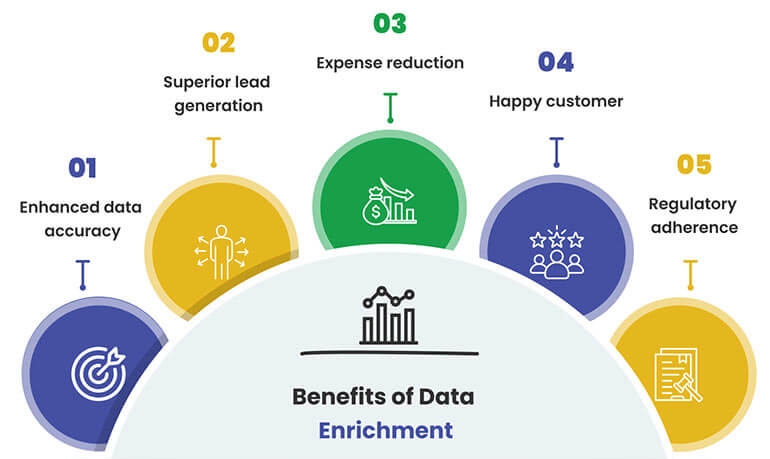
Image source hitechbpo.com
The enrichment of data is part of a larger overall data hygiene strategy, which includes other components like data cleansing (removing inaccurate or outdated data), data validation, and data migration.
Data cleansing and enrichment are two terms that are often used together in the context of data management for improved business operations. Both, data cleansing and enrichment are crucial for enhancing the quality of data, accessing a larger volume of data, and uncovering hidden patterns. They serve different purposes but are equally important in ensuring data accuracy and availability.
As mentioned above, marketing data enrichment refers to the process of adding more up-to-date data to a database by combining it with information from various other sources. Whereas, data cleansing involves addressing and updating inconsistent and unreliable data.
To begin with, you can enrich your data by connecting your database or storage to external data sources through data pipelines. This will enable you to add more data to your existing dataset. Once you have access to this data, you can then perform data cleansing by identifying and resolving any errors, inconsistencies, or missing information. By doing so, you will gain a better understanding of your data and be able to improve it.
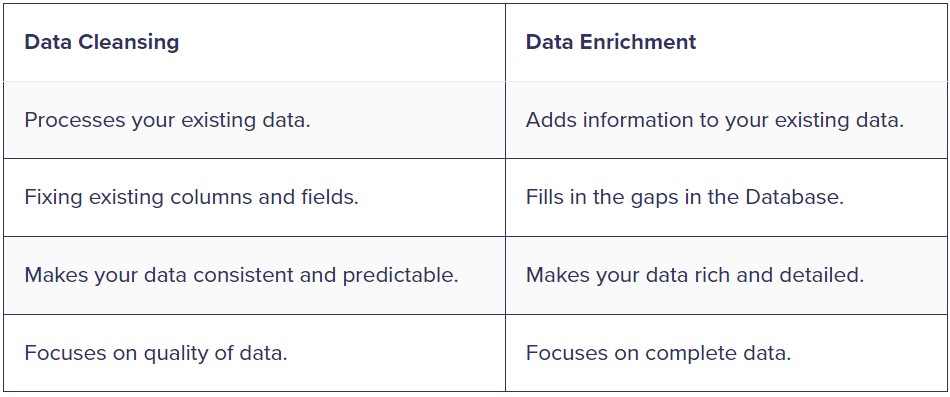
Image source hevodata.com
Research has shown that more than 60% of customers expect companies to meet their specific requirements and desires. This indicates that using a generic approach is no longer sufficient – organizations, particularly those engaged in lead data enrichment and B2B lead enrichment, must utilize data and behavioral analytics to identify the consumer’s preferences and timing.
In this perspective, customer data enrichment can provide numerous advantages to businesses, improving different aspects of their operations. Let’s look through some of the most crucial benefits of data enrichment below:
One major advantage is better user segmentation, allowing companies to understand their audience more comprehensively. Take Amazon, for instance, they use enhanced data to finely divide their user base and provide personalized recommendations and ads.
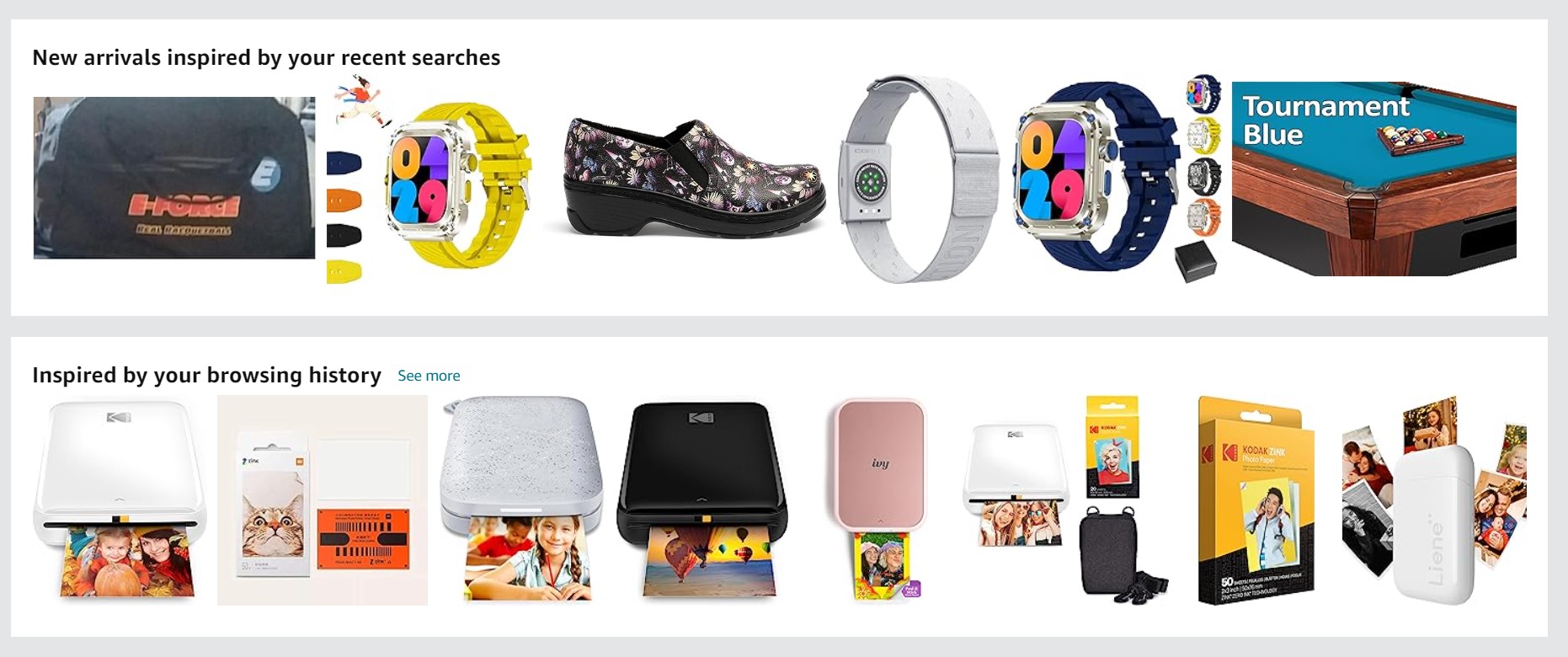
Improved user experience is achieved through enhanced data, allowing companies to offer personalized content, recommendations, and services by leveraging enriched customer insights. Most leading eCommerce businesses utilize enrichment techniques of data to analyze user behavior and preferences, resulting in a tailored shopping experience.
Enriched data contributes to reducing user friction through streamlined interactions. By analyzing detailed user profiles, companies enhance content recommendations, making it easier for users to discover content that aligns with their preferences. This ultimately leads to improved user satisfaction and retention.
Customer data enrichment plays a crucial role in reducing churn rates by proactively identifying potential issues and addressing customer needs. For example, Spotify uses data to gain insights into user listening habits, allowing them to create personalized playlists and content that helps retain subscribers.

Effective use of enriched data allows for streamlined and targeted communication, improving internal processes. For instance, Salesforce, a leader in customer relationship management, leverages marketing data enrichment to optimize sales processes and prioritize leads with the greatest potential.
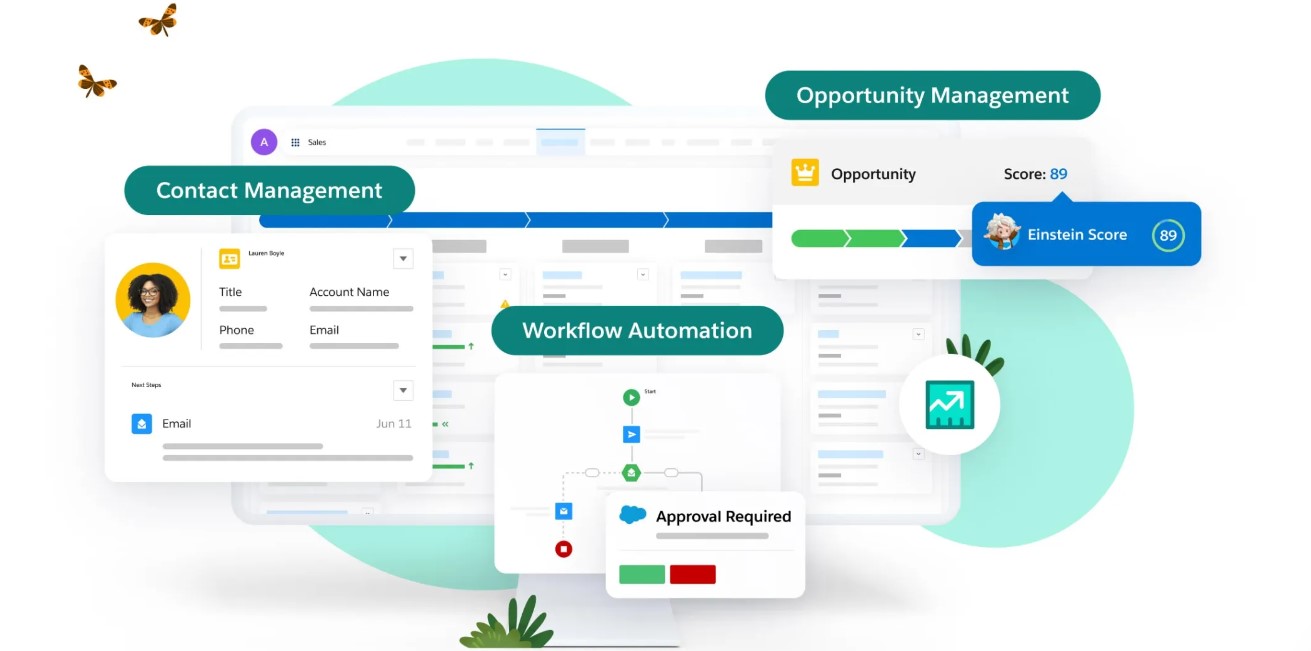
By filling in the gaps in the existing data, customer data enrichment enables scalable data collection. HubSpot uses enrichment to assist businesses in automating marketing campaigns and effectively handling customer relationships on a large scale.
The enrichment of data enables real-time verification and updates, guaranteeing the accuracy and relevance of information. For example, LinkedIn and other companies utilize data enrichment to validate user profiles, ensuring a dependable and current professional network.
Enrichment of data improves lead scoring and routing by offering more insights into the characteristics and behaviors of leads. All top marketing automation platforms use enriched data to effectively score leads, ensuring that sales teams give priority to valuable opportunities.
The enrichment process plays a key role in making forms more efficient by automatically filling in relevant information, which in turn reduces obstacles and boosts the conversion rate. An example is Google Maps, which utilizes enrichment to provide autocomplete suggestions, enhancing the user’s experience when searching for locations.
Data enrichment helps companies identify and improve their ideal customer profile, allowing them to concentrate on attracting and retaining valuable customers. Mostly B2B companies utilize enrichment of data to develop thorough buyer profiles, which in turn drive targeted marketing and sales strategies.
Enriched data is the basis for personalized interactions across different touchpoints. Netflix utilizes advanced recommendation algorithms to enhance data and gain insights into user preferences. This enables them to provide a highly personalized content experience, effectively keeping subscribers engaged. For example, once a user is vested in watching horror movies, Netflix will keep recommending horror movies.
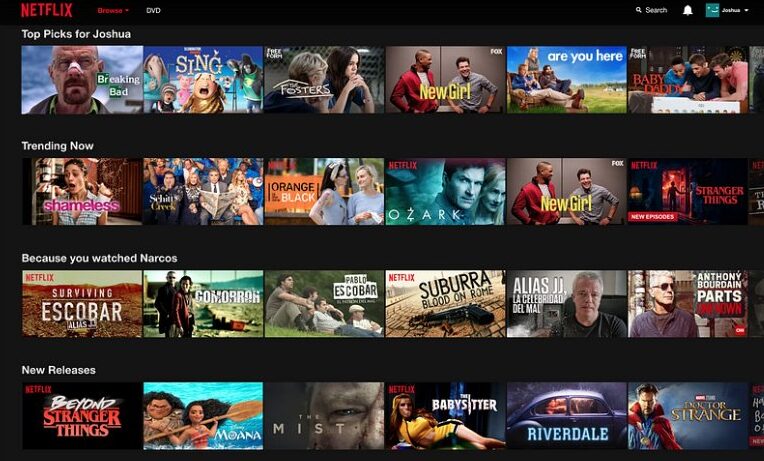
Last but not least, customer data enrichment can effectively reduce overall expenses. The reason behind this is that by prioritizing and enriching the data that holds significant, like customer contact details or transaction histories, companies can streamline their operations and minimize unnecessary costs.
Benefits of Data Enrichment:
Increase Business ROI
Targeted Marketing Campaigns
Enhance Customer Nurturing
Create Business Relationships
Improve Customer Response Rates
Improve The Brand #bestdataprovider #datawebster #companyinfo #bestdata #data #b2bdatabase #b2cdatabase pic.twitter.com/QtYqHhZIbm— Best DataProvider (@BDataprovider) December 30, 2019
Now that you have already become acquainted with the concept of enriching data and the advantages it can bring to your business, let’s delve into some important marketing data enrichment examples.
Extracting contact details, such as email addresses and phone numbers, from official websites provides businesses with accurate and up-to-date contact information, enabling seamless communication and fostering stronger relationships with clients and prospects.
Enhancing existing customer data with demographic details such as age, gender, income, and education level allows businesses to tailor marketing campaigns, personalize communication, and better understand the characteristics of their customer base.
By using Google search results for enrichment of data, companies gain a more comprehensive understanding of a company’s online presence, industry reputation, and relevant news. This information contributes to making better-informed decisions.
By incorporating details from social media platforms, such as job titles, interests, and connections, businesses can improve their personalization efforts, enhance targeted advertising, and gain valuable insights into user’s online behavior and preferences.
Customer data enrichment through reviews helps companies identify areas for improvement, enhance customer satisfaction, and refine their marketing and product development strategies.
Keeping an eye on relevant news articles provides companies with real-time insights into their industry, market trends, and brand perception. This data enrichment technique supports proactive decision-making and helps organizations stay responsive to external factors that may impact their business.
Finally, let’s dive into some best practices for data enrichment techniques that can become the secret sauce to a smarter, more effective data strategy.
When you’re enhancing your data with extra information, it’s important to make sure that the privacy and security of the data are not compromised. Opt for trusted data enrichment providers, secure sensitive data through encryption, and establish access controls. Many companies depend on machine learning-based fraud prevention solutions, which are reported to decrease fraud rates by an average of 70-80%.
By following a secure approach, you can keep your data protected and have peace of mind.
Always create clear criteria for the data enrichment process. Define the specific information you are looking for and how it relates to your goals. Whether you need demographic details, geospatial coordinates, or social media insights, having a well-defined roadmap will ensure you enrich your data with purpose and accuracy.
Consistency is key! Create a repeatable data enrichment process just like your go-to playlist. Record the steps, tools, and parameters used during the enrichment journey. Not only will this save you time, but it will also guarantee that each round of enrichment maintains the same rhythm, ensuring data integrity and reliability.
Think of data as the language your business speaks. To prevent any confusion, it is important to standardize how you enhance your data. Create a shared structure, formats, and conventions for your data. This not only simplifies communication within your organization but also enables seamless integration and comparison of enhanced datasets. When data processing is harmonious, valuable insights can be obtained.
Before starting your enrichment journey of data, make sure to consider several pre-data enrichment rituals:
Before getting started with the enrichment of data, take a moment to consider your real data needs. Are you looking to gain better customer insights, improve processes, or develop more effective marketing strategies?
Knowing what you want to achieve with your data is like having a compass – it will help guide you toward meaningful outcomes on your journey of enrichment.
Never skip the step of analyzing the existing information. Tools like Google Analytics, Mixpanel, or Hotjar can be your trusty sidekick. They help you understand how users interact with your website, what information you capture, and where the gaps lie.
Save your time and effort and consider automating data enrichment processes. Work automation tools are game changers assuring rapid data updates, minimizing data discrepancies, increasing data volumes without a proportional rise in workload, and more.
Choosing the appropriate method for marketing data enrichment is extremely crucial. Making the right decision can determine whether you gain valuable insights or get overwhelmed with irrelevant information. Let’s delve into three notable options: web scraping, manual research, and B2B data enrichment software. Each of these approaches has its benefits of data enrichment and factors to consider.
Web scraping is a fast and efficient way to gather large amounts of information from websites. It provides a continuous flow of fresh data, but it’s important to be mindful of legal and ethical considerations to avoid violating terms of service or privacy regulations. The decision to use web scraping depends on the amount of data needed and a careful commitment to ethical standards. This method is ideal for large businesses dealing with large amounts of data.

Image source kinsta.com
Manual research is still a reliable choice when it comes to obtaining accurate and detailed knowledge. Human curation guarantees a careful and considerate approach, especially when working with intricate or specialized data. Nevertheless, this method requires a significant investment of time and resources. Manual research is most effective for smaller datasets or situations where a human perspective is essential for understanding subtle information.
B2B data enrichment software like Clearbit, Cognism, Yesware, and more provide an efficient way to enhance business-specific information. With its scalability, automation, and systematic approach, this software seamlessly integrates with your current systems, allowing for a streamlined workflow, especially beneficial for B2B lead enrichment. Although there may be an initial investment required, the long-term advantages in terms of improved efficiency and accuracy are significant.
The enrichment of data is not a solution that can be applied universally; it is a customized and adaptable method to strengthen your decision-making capabilities.
Whether you prefer accuracy through manual research, efficiency through web scraping, or the automated sophistication of B2B data enrichment software, the crucial aspect is selecting an option that aligns with the specific requirements of your business.
Now that you are equipped with all the information about data enrichment techniques, you can confidently start your journey.
1. What is data enrichment, and why is it important for businesses?
It is the process of enhancing existing datasets with additional information, providing more comprehensive and valuable insights. It’s crucial for businesses as enriched data leads to improved decision-making, personalized marketing, and enhanced customer understanding.
2. How often should I enrich my data?
A typical method involves scheduling the data enrichment process quarterly or annually. Yet, for frequently changing data, more frequent enrichment may be necessary. In cases of real-time decision-making, near-real-time enrichment becomes crucial. It is essential to evaluate your data requirements and adjust your marketing data enrichment strategy accordingly.
3. How to understand if my data needs to be enriched?
If you want to understand if your data needs to be enriched, ask yourself the following questions:
4. How can data enrichment benefit my marketing campaigns?
Enriched data improves marketing campaign ROI by enabling more targeted and personalized communication. It helps identify and target the right audience, refine messaging, and enhance overall campaign effectiveness.